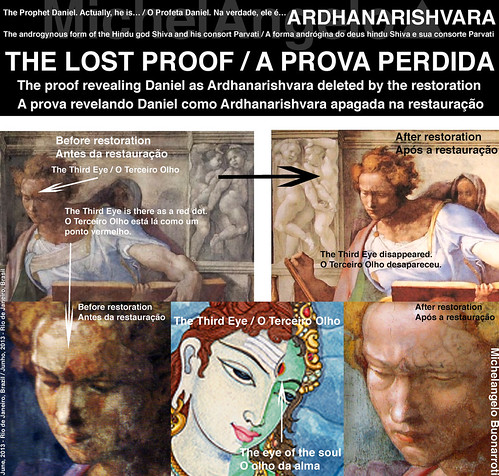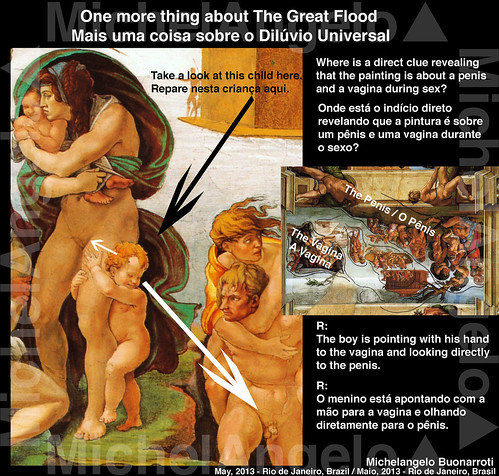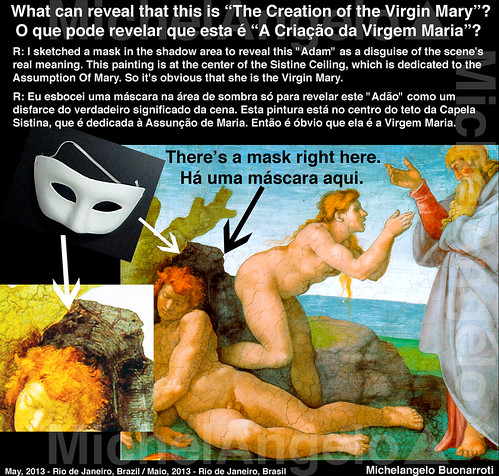The great discussion behind the stupid restoration of the Sistine Ceiling is about my process of painting and the technique used. The "genius" who decided to erase completely every layer took for granted that I worked only on wet plaster, the so called "buon fresco". Now the only thing left is the rethoric defense of the disaster.
What I will never understand is why they kept the chemical process of cleaning when parts of the figures, like eyes and toes, were vanishing right in front of their eyes!!!
When the restoration was announced, I was still in my self analysis phase colecting proofs of my condition of being Michealngelo's reincarnation. I really liked the chance to compare my personal experience to the visual results of the restoration. All the details that came to light matched perfectly with what I already knew about myself. I knew it was impossible that I had achieved such depth on the paintings only working on the wet plaster. And I LOVE to retouch details when I see a more expressive solution. It was obvious that I worked over the dry plaster, using some "a secco" technique.
Well, now I'm revealing that even the true meaning of the Sistine Ceiling was affected by the ignorants who carried out the destructive restoration. Of course there were many details of my secret agenda that I did only when I found myself alone on the scaffolding, mostly a day before the dismantling of it. So most of them were done on the dry plaster.
There are still some missing details but I can't be sure that they disapeared because of the restoration done in the XX century. I saw some interviews with "art experts" giving their opinion about the Sistine Ceiling and I heard an old lady stating that the paintings express a "very bad theology". I can't remember a better example of today's ignorance about the past events. People who don't even know what is expressed on the Sistine Ceiling claim the right of explaining it. It only could lead to a disaster of epic proportions like the f… restoration.
But you all don't need to worry. The paintings still have most of the secret signals that I left and I can prove myself as Michelangelo's reincarnation any time that I want to.
References:
en.wikipedia.org/wiki/Restoration_of_the_Sistine_Chapel_f...
Português:
A grande discussão por trás da boçal restauração de teto da Capela Sistina é sobre o meu processo de pintura e a técnica utilizada. O "gênio" que decidiu raspar todas as camadas da pintura tinha como certo que eu trabalhei apenas sobre gesso úmido, o chamado "buon fresco". Paciência. Agora, só resta a defesa retórica da catástrofe.
O que nunca vou entender é porque eles mantiveram o processo químico de limpeza, quando partes da figura, como olhos e dedos dos pés, estavam desaparecendo na frente de todos!!!
Quando a restauração foi anunciada, eu ainda estava na minha fase de auto-análise, coletando provas da minha condição de ser a reencarnação de Michelangelo. Por isso, eu realmente gostei da oportunidade de comparar a minha experiência pessoal com os resultados visuais da restauração. Todos os detalhes que vieram à luz combinaram perfeitamente com o que eu já sabia sobre mim. Eu sabia que era impossível que eu tivesse conseguido tal profundidade na pintura só trabalhando no gesso molhado. E eu ADORO retocar detalhes quando vejo uma solução mais expressiva. Era óbvio que eu tinha trabalhado sobre o gesso seco, usando alguma técnica "a secco".
Bem, agora eu estou mostrando que até o verdadeiro sentido do teto da Capela Sistina foi afetado pelos ignorantes que realizaram a destrutiva restauração. É claro que haviam muitos detalhes do meu planejamento secreto que eu só fiz quando me via sozinho no andaime, principalmente um dia antes da desmontagem do mesmo. Assim, a maioria desses detalhes foram realizadas sobre o gesso seco. Existem ainda alguns detalhes que estou dando pela falta, mas não posso ter certeza de que desapareceram por causa da restauração feita no século XX.
Vi algumas entrevistas com "especialistas em arte", dando a sua opinião sobre o Teto da Capela Sistina e ouvi uma senhora dizendo que as pinturas expressam uma "péssima teologia". Não conheço exemplo melhor da ignorância de hoje sobre os eventos passados. Pessoas que sequer sabem o que está expresso no Teto da Capela Sistina reivindicam o direito de explicá-la. Tudo isso só poderia levar a um desastre de proporções épicas, como a tal restauração.
Mas vocês não precisam se preocupar. As pinturas ainda guardam muitos dos sinais secretos que fiz e posso provar que sou o próprio Michelangelo Buonarroti a hora que eu quiser.
Referências:
en.wikipedia.org/wiki/Restoration_of_the_Sistine_Chapel_f...















